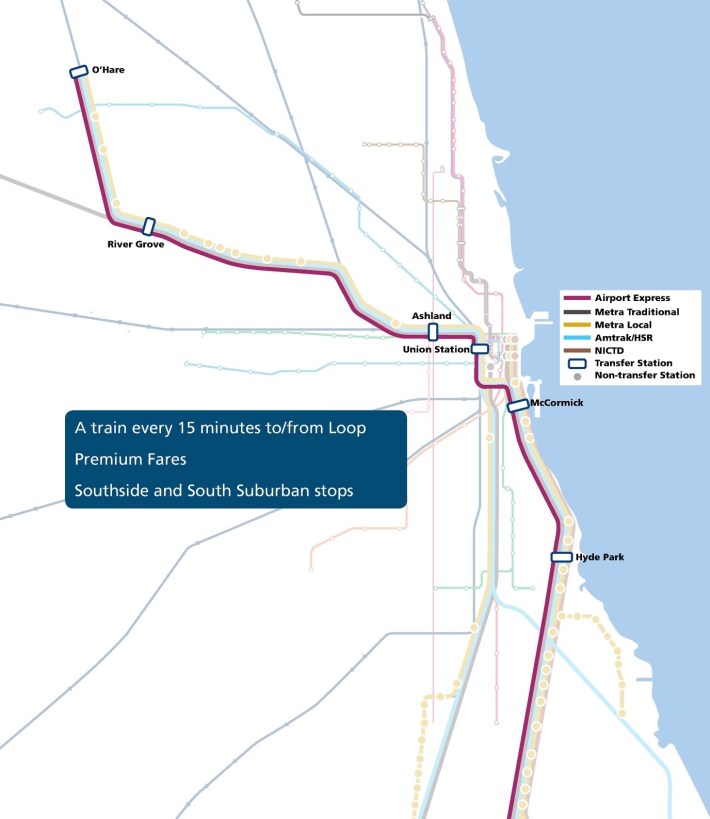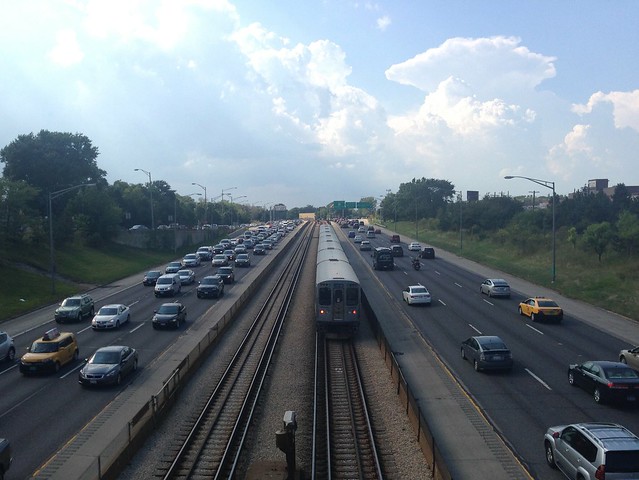It looks like there may actually be some traction for Mayor Rahm Emanuel’s grand plan for express rail service to O’Hare Airport. Yesterday the city announced that by March it will select an engineering team to develop conceptual designs, including routes and terminal options.
The CTA Blue Line is already an efficient way to travel between O’Hare and the Loop, which could easily be improved through a few simple upgrades. But last year Emanuel and aviation commissioner Ginger Evans stated that the airport express service was a priority for the administration.
Evans even threw out the rather far-fetched idea of double-decking the Blue Line to make room for the express trains. And, of course, Emanuel’s proposal is overshadowed somewhat by former mayor Richard M. Daley’s failed attempt to establish an O’Hare express train. That resulted in the city spending $250 million to build a superstation under the Loop’s Block 37, which now sits empty.
With Emanuel under attack for multiple police scandals and the Chicago Public Schools financial crisis, it seems like an odd time to move forward with a plan that would largely benefit the well heeled folks who’d be willing to pay a premium for a faster ride to the airport. But yesterday’s news release made a few other arguments for the proposal, asserting that it would help take cars off the region’s roadways, encourage more investment in the city, and create long-term jobs.
In March, the aviation department will pick an engineering team to analyze and develop conceptual designs for the rail service and lay out an overall timeline for the project. The city recently put out a request for proposals from vendors who were asked to develop designs. The department will be choosing from the three proposals that were submitted. The final proposal will evaluate the different options for the express service’s route, terminals, and amenities.
The news release acknowledges Daley’s ill-fated effort to establish high-speed transit to the airport. “Previous attempts to create an express rail service from O’Hare and downtown focused on using existing, heavily-utilized rail stations, which prevented the plans from being feasible,” it states. “Understanding these limitations, [the aviation department] is now asking vendors to focus its attention on other ways to build the rail service while avoiding previously identified obstacles.”
The city says it will start negotiations with relevant stakeholders this year, and a contract for the final design, construction, and financing of the project could be awarded in 2017. There’s no cost estimate for the project yet, but a business plan for the airport express created for the CTA in 2006 estimated that a Blue Line-parallel service with separate tracks would cost $1.5 billion. Yesterday's release says the city's goal is to make sure that the luxury rail service can be built without taxpayer money.
Large transit projects in Chicago are usually paid for with federal grants, but it looks like Emanuel might pursue a public-private partnership here instead. It’s unclear whether the premium O’Hare service would generate enough revenue to pay back a private investor.

Another funding possibility is airport passenger facility charges. These normally can't be used for projects located outside of an airport, but perhaps the Emanuel administration will try to persuade federal authorities to let them bend this rule.
At any rate, it’s important for Emanuel follow through with his pledge not to spend taxpayer money on rail service that most Chicagoans wouldn’t use. It would be inequitable if luxury train service was to divert tax revenue from more pressing neighborhood transit improvements.
On the other hand, there is a scenario where the O’Hare Express could have wider benefits for Chicago residents. The Midwest High Speed Rail Association says the airport plan should use existing Metra, rather than CTA, infrastructure as part of a proposal called “CrossRail,” with an estimated cost of $2.2 billion.
Cross Rail is a package of Metra rail improvements that MHSRA says would increase the commuter rail system’s reliability and create rider-friendly service patterns. The plan calls for linking the Metra Electric tracks with Union Station, by way of a new flyover and river crossing at 16th Street.
Investing in upgrades for an O’Hare express on Metra tracks could address the commuter rail service’s existing needs. Metra wants to upgrade track switches – the A2 switch dates back to 1932 – within Chicago that delay trains, and eliminate dangerous at-grade road crossings near the airport.
And, since CrossRail would connect the Union Station lines with the Metra Electric, which serves the South Side and south suburbs, there would be a wide base of political support for the investment. In other words, unlike a Blue Line-based O’Hare express service, CrossRail wouldn’t just be a project for relatively wealthy people traveling between the airport and the Loop.
Read more about the CrossRail proposal here.
![]()
Did you appreciate this post? Streetsblog Chicago is currently funded until April 2016. Consider making a donation through our PublicGood site to help ensure we can continue to publish next year.




